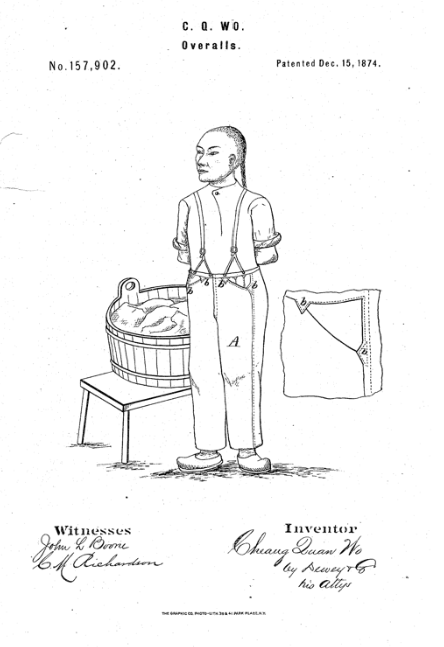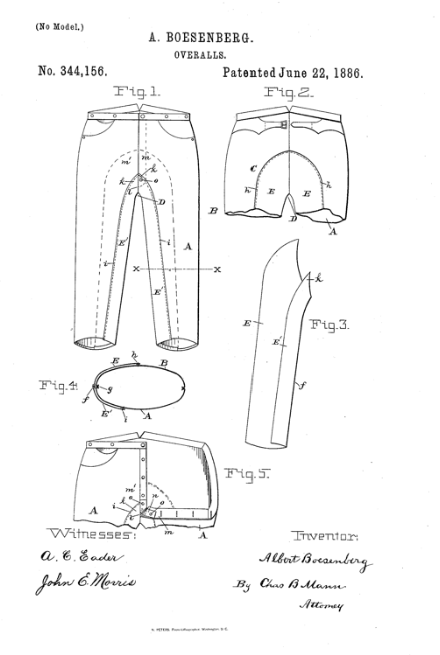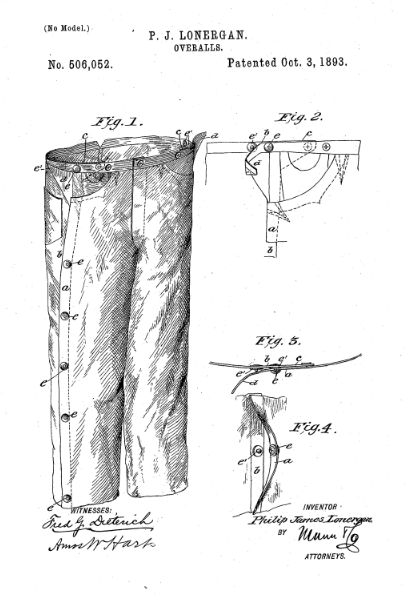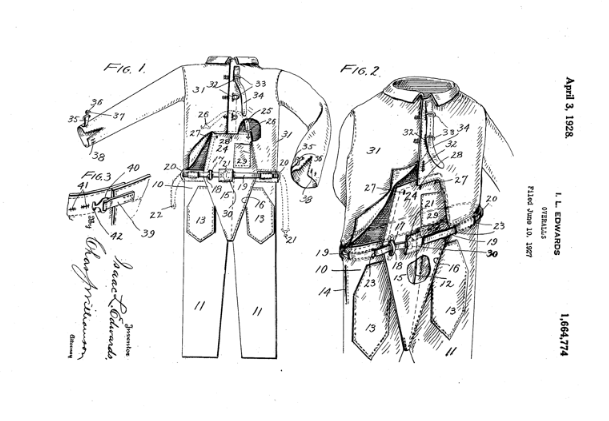JAMES AGEE’S SEMINAL NOVEL Let Us Now Praise Famous Men was published in 1941 with Walker Evans’ poignant photographs at the height of the Great Depression. During Franklin Roosevelt’s ‘New Deal’ program, the pair were commissioned for eight weeks in America’s South to document the living conditions of sharecropper workers. Evans’ stark images, paired with Agee’s words creates an empathetic and profound document of the sufferings of these families during this time. Intended as a ‘photographic and verbal record of the daily living and environment of an average white family of tenant farmers’, the book goes much further in its eloquent descriptions where Agee seems at times a character himself in the narrative. In one particular passage, Agee eloquently details the workwear garments worn by the characters in the book he observed.
‘So far as I know, overalls are a garment native to this country. Subject to the superstitions I have spoken of, they are, nevertheless, the standard or classical garment at very least (to stay within our frame of the southern rural American working man: they are his uniform, the badge and proclamation of his peasantry. There seems to be such a deep classicism in ‘peasant’ clothing in all places and in differing times that, for instance, a Russian and a southern woman of this country, of a deep enough class, would be undistinguishable by their clothing: moreover, it moves backward and forward in time: so that Mrs. Ricketts, for instance, is probably undistinguishable from a woman of her class five hundred years ago. But overalls are a relatively new and local garment.
***
Perhaps little can be said of them, after all: yet something. The basis, what they are, can best be seen when they are still new; before they have lost (or gained) shape and colour and texture; and before the white seams of their structure have lost their brilliance.
Overalls.
They are pronounced overhauls.

Try—I cannot write of it here—to imagine and to know, as against other garments, the difference of their feeling against your body; drawn-on, and bibbed on the whole belly and chest, naked from the kidneys up behind, save for broad crossed straps, and slung by these straps from the shoulders; the slanted pockets on each thigh, the deep square pockets on each buttock; the complex and slanted structure, on the chest, of the pockets shaped for pencils, rulers, and watches; the coldness of sweat when they are young, and their stiffness; their sweetness to the skin and pleasure of sweating when they are old; the thing metal buttons of the fly; the lifting aside of the straps and the deep slipping downward in defecation; the belt some men use with them to steady their middles; the swift, simple and inevitably supine gestures of dressing and of undressing, which, as is less true of any other garment, are those of harnessing and of unharnessing the shoulders of a tired and hard-used animal.

They are round as stovepipes in the legs (though some wives, told to, crease them).
In the strapping across the kidneys they again resemble work harness, and in their crossed straps and tin buttons.
And in the functional pocketing of their bib, a hardness modified to the convenience of a used animal of such high intelligence that he has use for tools.
And in their whole stature: full covering of the cloven strength of the legs and thighs and of the loins; then nakedness and harnessing behind, naked along the flanks; and in front, the short, squarely tapered, powerful towers of the belly and chest to above the nipples.

And on this facade, the cloven halls for the legs, the strong-seamed, structured opening for the genitals, the broad horizontal at the waist, the slant thigh pockets, the buttons at the point of each hip and on the breast, the geometric structures of the usages of the simpler trades–the complexed seams of utilitarian pockets which are so brightly picked out against darkness when the seam-threadings, double and triple stitched, are still white, so that a new suit of overalls has among its beauties those of a blueprint: and they are a map of a working man.

The changes that age, use, weather, work upon these.
They have begun with the massive yet delicate beauty of most things which are turned out most cheaply in great tribes by machines: and on this basis of structure they are changed into images and marvels of nature.
The structures sag, and take on the look, some of use; some, the pencil pockets, the pretty atrophies of what is never used; the edges of the thigh pockets become stretched and lie open, fluted, like the gills of a fish. The bright seams lose their whiteness and are lines and ridges. The whole fabric is shrunken to size, which was bought large. The whole shape, texture, color, finally substance, all are changed. The shape, particularly along the urgent frontage of the thighs, so that the whole structure of the knee and musculature of the thigh is sculptured there; each man’s garment wearing the shape and beauty of this induplicable body. The texture and the color change in union, by sweat, sun, laundering, between the steady pressures of its use and age: both, at length, into realms of fine softness and marvel of draping and velvet plays of light which chamois and silk can only suggest, not touch; and into a region and scale of blues, subtle, delicious, and deft beyond what I have never seen elsewhere approached except in rare skies, the smoky light some days are filmed with, and some of the blues of Cézanne: one could watch and touch even one such garment, study it, with the eyes, the fingers, and the subtlest lips, almost illimitably long, and never fully learn it; and I saw no two which did not hold some world of exquisiteness of its own. Finally, too; particularly athwart the crest and swing of the shoulders, of the shirts: this fabric breaks like snow, and is stitched and patched: these break, and again are stitched and patched and ruptured, and stitches and patches are manifolded upon the stitches and patches, and more on these, so that at length, at the shoulders, the shirt contains virtually nothing of the original fabric and a man, George Gudger, I remember so well, and many hundreds of others like him, wears in his work on the power of his shoulders a fabric as intricate and fragile, and as deeply in honor of the reigning sun, as the feather mantle of a Toltec prince.

Gudger has three; it is perhaps four changes of overalls and workshirts. They are, set by set, in stages of age, and of beauty, distinctly apart from one another; and of the three I remember, each should at best be considered separately and at full length. I have room here to say only that they represent medium-early, middle, and medium-late stages, and to suggest a little more about these. The youngest are still dark; their seams are still visible; the cloth has not yet lost all of its hardness, nor the buttons their brightness. They have taken the shape of the leg, yet they are still the doing as much of machinery as of nature. The middle-aged are fully soft and elegantly textured, and are lost out of all machinery into a full prime of nature. The mold of the body is fully taken, the seams are those of a living plant or animal, the cloth’s grain is almost invisible, the buttons are rubbed and mild, the blue is at the full silent, greatly restrained strength of its range; the patches in the overalls are few and strategic, the right knee, the two bones of the rump, the elbows, the shoulders are quietly fledged: the garments are still wholly competent and at their fullness of comfort. The old: the cloth sleeps against all salients of the body in complete peace, and in its loose hangings, from the knee downward, is fallen and wandered in the first loss of form into foldings I believe no sculptor has ever touched. The blue is so vastly fainted and withdrawn it is discernible scarcely more as blue than as the most pacific silver which the bone wood of the houses and the visage of genius seem to shed, and is a color and cloth seeming ancient, veteran, composed, and patient to the source of being, as too the sleepings and the drifts of form. The shoulders are that full net of sewn snowflakes of which I spoke. The buttons are blind as cataracts, and slip their soft holes. The whole of the seat and of the knees and elbows are broken and patched, the patches subdued in age almost with the original cloth, drawn far forward toward the feathering of the shoulders. There is a more youthful stage than the youngest of these; Ricketts, in his photograph here, wears such overalls; there are many median modulations; and there is a stage later than the latest here, as I saw in the legs of Woods’ overalls, which had so entirely lost one kind of tendency to form that they had gained another, and were wrinkled minutely and innumerably as may best be paralleled by old thin oilskin crumpled, and by the skin of some aged faces.